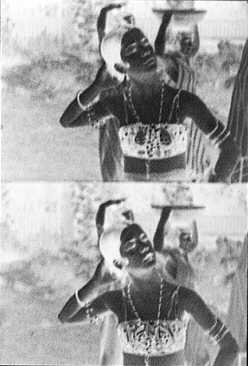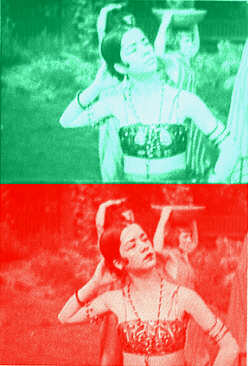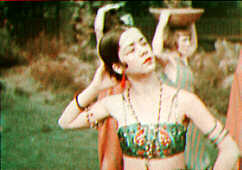
Shown at top is the red record, at bottom the green record.

Technicolor® is documented in a separate section dedicated to the history of the company and the various process and refinements from 1912 thru the present.
Subtractive color processes proved far more practical to exhibit than were additive systems. This is because standard projectors could be used to show the films which had only one composite color record for each frame. Color films, in other words, could be handled exactly the same way that black & white films could. An additional benefit is that the color information could be adjusted in the laboratory to enhance the final image. Subtractive color processes came to the forefront late in the pre-three color Technicolor period, though some had their roots going back to the turn of the century.
Two Color Kodachrome (1915) This process had no relationship to Eastman Kodak's marvelous single film color reversal process that was unveiled in 1935. Like all other processes at the time, it recorded its color records on separate frames, using a camera carrying two negatives. These two negatives were printed on either side of a single 35mm film which had an emulsion on both sides. The film was then chemically treated to create a blue/green image on one side and a red/orange image on the other. Color accuracy, like any two color system, was compromised, but the results were pleasant. If the proper care was taken in photography, a fairly broad color spectrum could be presented on the screen. The process had many similarities to Technicolor process 2.
The First Successful Subractive Color Process

Shown at top is the red record, at bottom the green record.

Here we see the processed positive film records after treatment to add color. These images would be on opposite sides of the film. Note that the color elements receive complementary colors, the red record being converted to blue/green and the green record being converted to red/orange. This is the basis for all subtractive color systems.

One problem with 2-color Kodachrome, also shared by Technicolor process #2, was the image being printed on both film surfaces made it more subject to scratching of the emulsion. Since scratches and other damage would be unique to only one of the colors, the results were perhaps more disturbing than a scratch through all the emulsion layers on a single sided film.
Black & white negative images duplicated from The International Encyclopedia of Film © 1972 Rainbird Reference Books Limited, London. The color images were created at The American WideScreen Museum and Film Technology Center, Houston, Texas, U.S.A.©1996View Kodachrome Samples
Return to Start Page
©1997-1998 The American WideScreen Museum
Martin Hart